The Big Climate Fightback: Tree Planting at Little Assynt
,
Guest Blog by Alison Roe
Saturday 30th November
Quinag looms high on the horizon, glowing gently in the afternoon sun as I pull into the car park by the tree nursery at Little Assynt. I’m here for the tree planting event, organised by CALLP in partnership with The Woodland Trust, and we’re definitely lucky with the weather. Rain and high winds are forecast for the coming week but today it’s beautiful – cold and clear – a great day to be outside and good conditions for planting trees.
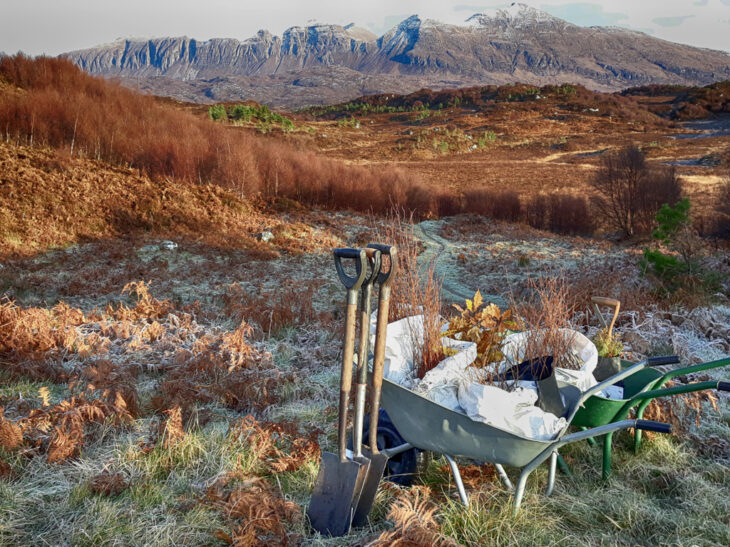
The area to be planted is just a few minutes walk along the path from the car park: a little hollow open to the east with views over to Quinag. Even though I’ve arrived quite early, there are already quite a few folk busy with spades, with Elaine on hand to explain what to do. I comment on the beauty of the location. Elaine explains that they chose this particular spot for its easy access and for its suitability for planting: it’s not too steep and is mostly grass and bracken so there’s plenty room for more trees.
There is a lot more woodland on the surrounding land though, a mixture of naturally occurring and planted trees, mainly birch, hazel, willow, and a few rowans. The area has been planted twice previously, in 2003 and again in 2013 – at the tree nursery’s first public planting event – but the existing fences weren’t able to keep all the deer out so some of the trees got munched. Since then a new deer fence has been put in, completely enclosing an area of about 600 hectares, which includes 400 hectares of woodland (90% of the woodland on the Little Assynt estate). This new fence completely excludes the deer, giving the woodland the opportunity to really thrive, and the small number of deer already living within the fenced area are being culled by a community stalking group. Once these deer have been reduced in number, CALLP plan to plant a further 40 to 50 hectares.
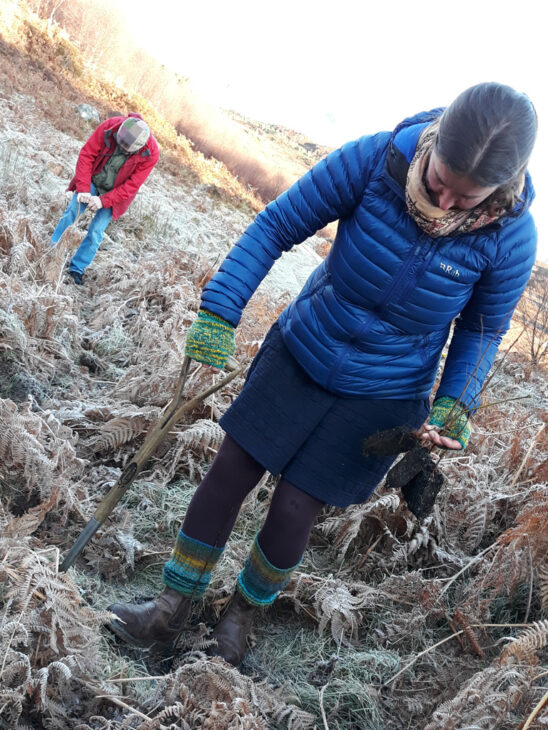
All the trees being planted here are native species and are planted in the proportions in which they would naturally be expected to grow here. Today, we have a few wheelbarrowfuls of trees to choose from, all young saplings about a foot high. Half of them are birch (the natural proportion), along with aspen, oak, hazel and juniper. They’re properly local too: all the saplings have been grown in the polytunnels here from seeds collected locally by Nick, the tree nursery manager. Some, like the birch, will have been sown just this spring while other species, like the oak and juniper, have taken a few years to be ready for outside planting.
After choosing a tree, we then have to choose where to plant it. Elaine explains that different species are suited to different habitats, even within this small area. Juniper will do best up on the hillside by the craggy outcrops. Hazel tend to do well there too, while the others can be placed among the smoother hillsides and flatter areas. Elaine then show us how to plant them. Rather than having to dig a big hole in the ground, all we have to do is make two perpendicular cuts in the soil with the spade to form a T shape, shoogle the spade to open the soil just enough to place the tree in, then press down the soil around it. The final test is to pull on it gently: if it stays in, then job done.
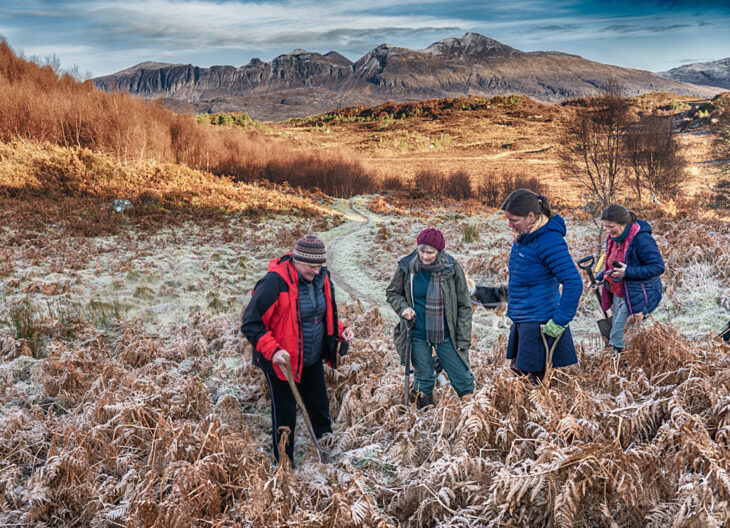
It’s straightforward enough. However, although it’s beautifully sunny, it’s also very cold and some of the planting area is still in the shade. Not only has the morning’s frost not yet melted but the ground is actually frozen in places. Thankfully it’s only superficially frozen so it’s easy enough to break the soil. I say ‘easy’ but that’s only because much of the hard work has been done by someone else. We’re not digging directly into the grass but are planting our trees in screefs – areas of about a square foot in size which have been cleared of turf and bracken, 300 of which were made yesterday by local planting contractor, David McPhail. This wasn’t actually done to make it easier for us planters (though I’m very appreciative) but for the young trees. Clearing the vegetation this way gives the tree a better chance when it starts growing in the springtime, as the removal of nearby plants and roots means it has less immediate competition for nutrients in the soil.
In any event, it’s a lovely way to spend the afternoon, outside in the crisp sunshine and frost-edged grasses under the great raked face of Quinag, its peaks and ridges lightly dusted with snow. Several people comment on how nice it is to be out on a cold day, keeping warm by doing something active. And it’s good craic too. There are folk of all ages and backgrounds – toddlers, pensioners, families, couples, locals, visitors. I even hear one man telling Elaine he’s come up from Troon in Ayrshire specially for this event, which he’d seen on The Woodland Trust website.
As well as the psychological boost of doing something useful in good company, there are tangible rewards as well: a great spread of sandwiches, cakes and traybakes are laid out in one of the polytunnels along with hot lentil soup and tea and coffee.
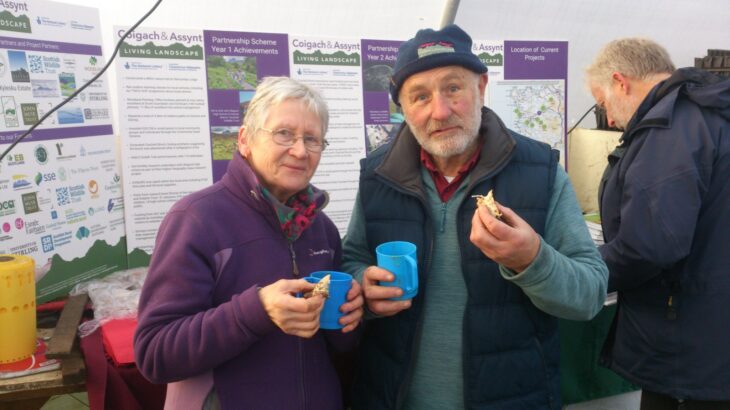
There has evidently been a lot of preparation by CALLP staff and volunteers for this event, and it has paid off. Over the course of the afternoon, 40-odd people have come, planting several trees each, with some people staying and planting for the whole afternoon. Elaine and Don actually have to make more screefs as the day goes on to keep up with demand, resulting in over 350 trees being planted.
The afternoon is clearly a success for all involved, and not just in Assynt. While this particular event was a joint effort by CALLP and The Woodland Trust, similar events have been going on simultaneously all over the UK, all organised by The Woodland Trust as part of ‘The Big Climate Fightback’.
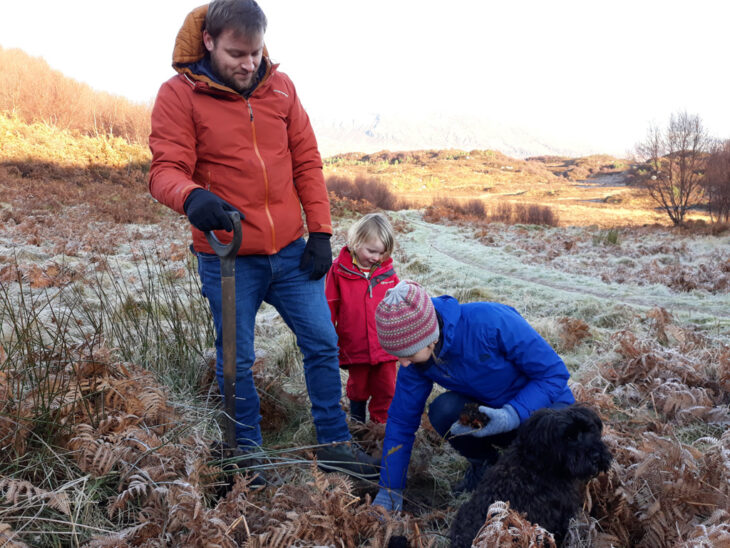
The aim of this project is to raise awareness of climate change and the important role tree-planting can play in countering it, as well as getting a good number of trees in the ground. The project seems to have succeeded on both counts, with good turn-outs at events across the UK. Some events – in places with denser populations – resulted in the planting of a few thousand trees, though I doubt if any other event took place in such a spectacular setting or with such excellent soup and sandwiches…
This Little Assynt tree planting event was probably also the only one to welcome participants with an on-site climate change quiz. This took the form of a series of laminated cards mounted on wee posts set at intervals along the path to the planting area. Each card had a question about climate change and a choice of four answers. The first question set a serious tone, laying out the connections between global warming and rising sea levels. However, after this, the choice of answers became increasingly hilarious, my personal favourite being question 6:
As global temperatures rise, areas in the Arctic could release even more greenhouse gas because:
- a) The urge to do spring cleaning up north would be so great that the increase in vacuum use would use up a ton of energy, burning fossil fuels in the process.
- b) Bigfoot, a notoriously gassy species, would come out of hibernation.
- c) Locals would burn their jackets to celebrate the milder winters, releasing greenhouse gases.
- d) The frozen ground contains greenhouse gases like methane and carbon dioxide, and when the ground thaws, the gas would be released.
The quiz was a nice touch that typified the atmosphere of the day’s activity: light-hearted and enjoyable yet with an undeniably serious undertone. This is how it should be. We all know that serious work needs to be done to face the environmental challenges we’ve created for ourselves. Yet enough psychological studies by now have shown that we’re most productive when we’re feeling motivated and inspired. Conversely, it’s been clearly demonstrated that feeling helpless and depressed saps our energy and tends to make us more passive.
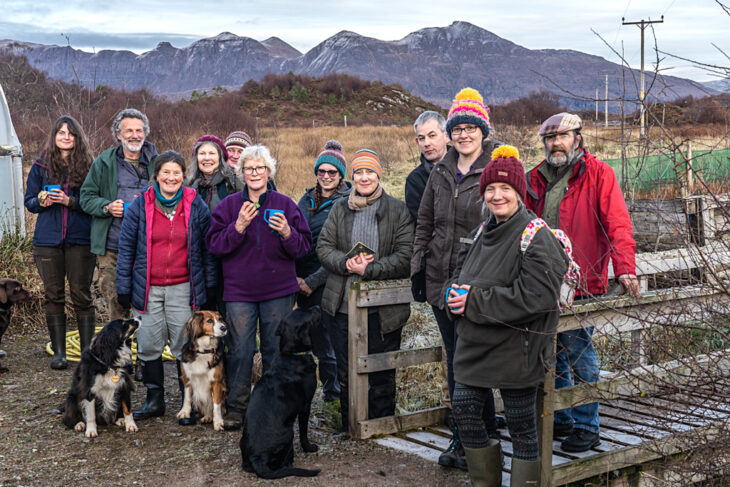
So thank you to all the CALLP staff and volunteers for getting us doing something useful while also enabling us to have a good time in the process. Every little helps (we need to reclaim this phrase from Tesco) and the more we enjoy doing environmental work, the more we’ll get on and do it. It was also, incidentally, a fitting way to spend St Andrew’s Day, doing something lasting for our country.
So what’s next? Well, if you fancy doing some tree planting but couldn’t come along on Saturday, or you’ve got a taste for it and want to do more, CALLP are aiming to organise an informal tree planting gathering in the spring. In the meantime, if you want to do a bit of planting or volunteer to help out in any other way, just get in touch with Elaine or Vickii at CALLP:
emacaskill@coigach-assynt.org
vcampen@coigach-assynt.org
Alison Roe
